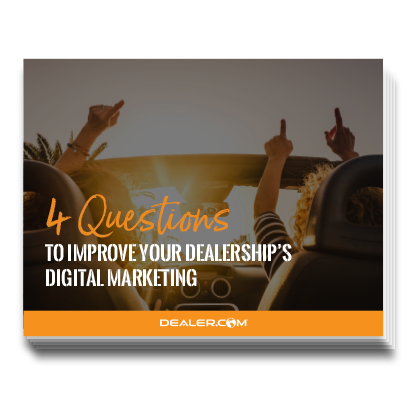By Lori Wittman, SVP Dealer Software Solutions, Cox Automotive
Challenges and difficulties breed innovation. It’s through adversity that some of our most inspiring discoveries are found. So, for businesses and organizations coming through a long period of adaptation—like the last eighteen months—I commend you.
Simply surviving as an organization is an accomplishment. But you and I can probably agree, there are key differences between surviving and thriving. When I look at the data (and I am always looking at the data), most automotive dealerships fall into one of two categories.
There are dealerships that survive hardships. And then there are dealerships that thrive. So called “thrivers” manage to become both more efficient and more profitable, while static dealerships either stay the same or became less efficient and less profitable.
For me, understanding what led to these differences in performance is a personal mission. Our dealer partners rely on the experience, insights, and technology we provide to guide important business decisions. It’s on us to dig into the data and discover the difference between the dealers who embrace digital acceleration and those who double down on old habits. It turns out, the data goes deep.
Our team at Cox Automotive has compiled a report called, “How to Thrive: Best Practices for an Accelerated Digital Landscape.” In it, we reveal insights from interviews and surveys of more than 450 franchise dealerships. The report uncovers the specific strategies employed by dealerships that thrive and how those dealers found success when the industry suddenly shifted to a digitally driven model.
So why do these insights matter now? Hindsight is a wonderful tool for discovering why going above and beyond in a crisis is beneficial to the customer experience. It reveals where we exceeded expectations and where we fell short.
But, in this case, hindsight is only 2020. And midway through 2021, I’m more interested in looking forward.
Once we are better able to establish a clear pattern that our dealer partners can learn from and follow, only then can we truly provide the insights that make a difference. By focusing on consumer experience and embracing digital capabilities, our entire industry levels up. And it does so in the following four, clear and specific ways:
- Thrivers offer digital options across the experience.
- Thrivers maximize their utilization of data.
- Thrivers invest in their staff.
- Thrivers adapt to customer desires in fixed ops.
Along with my colleagues at Cox Automotive, I’ve been shouting it from the rooftops for years: “The transition to digital car shopping and buying is coming!” I had no idea how quickly we would be proven right. So, while the recent jump in demand for online and digital retail in automotive wasn’t entirely unexpected, it was certainly accelerated. And frankly, it was long overdue.
The way we live our lives has been changing since the onset of the internet. Car shoppers had already been preconditioned by other online retailers (think streaming entertainment, same-day shipping, online banking, etc.) to accept and expect a more digitally driven process. Buyers have always wanted to complete more of the process online. Now, with the tools available to dealers and an increase in trust from our buyers, consumers are more comfortable sharing personal financial data with dealers across a number of channels in order to make that happen.
Thriving dealers didn’t view this rushed transition as a crisis for their businesses. Instead, they jumped at the opportunity. The “How to Thrive” report showed that a full 82% of thrivers agree that offering more digital options to customers is critical to the retail success of a dealership. With digital transformation as a priority, they shored up their systems to ensure they were offering flexible options throughout the shopping experience. They added digital buying solutions and communications channels to give their customers the ability to start and complete the shopping and buying process from anywhere.
As it became apparent that major shifts would take place, top-performing dealerships began examining their digital retailing ecosystems and identifying gaps in their online shopping processes. In fact, 62% of thrivers improved processes to support selling a vehicle online, compared to only 31% of static dealerships. Customers of thrivers immediately experienced the benefits, taking advantage of the flexibility and convenience associated with seamless remote shopping. Dealers that adjusted also saw the benefits as they got faster at structuring deals, closing sales, and receiving funds.
I recently had the chance to talk with Linda Crossman, Director of System Operations and Training at Byers Automotive Group, to discuss the findings of the “How to Thrive” report. In our conversation, Linda shared the details of her dealership’s experience improving its online processes amidst last year’s unique challenges. Specifically, Byers Automotive Group refined and even branded its online shopping and purchase process.
“We actually understood pretty quickly that we needed to change the way we do business because that’s what our customers were requesting from us,” Linda said. “So, we came up with a process that we call ‘The Byers Express,’ which is four easy steps online that a customer can go in and choose their car, choose what kind of financing, and more.”
Naturally, as more shoppers began completing more of the process online, dealerships encountered challenges associated with customer communications. Thriving dealers overcame these challenges by embracing an omnichannel communication approach, including text, video chat, and other communications that get tracked in the CRM. More than half (56%) of thrivers use a variety of communication options to align with shopper preferences, while only 32% of static dealers can say the same. Adding or increasing utilization of those channels made the car buying process more personal.
I was so impressed with the way that Linda and Byers Automotive Group addressed the communications component of digital acceleration.
“You have to offer up whatever way they feel comfortable in communicating with you,” Linda explained to me. “For some people, it’s going to be text messaging, for some people it’s going to be chat, for some people it’s going to be through email, and some people still like the traditional way of phone. So, we offer up every single one of those options for our customers so they can choose the way they want to communicate with us.”
Thrivers Maximize Their Utilization of Data
Dealers continue to tell me how valuable it is to have data continuity across their systems, whether it’s entering information into the digital retailing tool or having access to that information all the way through the signing ceremony. According to the “How to Thrive” report, 86% of dealers agree that having accurate and complete data is a priority at their dealership.
The pandemic definitely proved the importance of keeping good data. When a dealership’s sales pipeline begins to dry up, as it can unexpectedly, dealership data can help identify new opportunities. Thriving dealerships leverage their data and their technology systems to proactively identify new sales and service opportunities.
Specifically, thrivers engage in online activity tracking of consumer web and search history to understand customer needs and interests. This allows them to personalize communications, digital marketing, and the car buying experience for each individual customer.
Dealerships that maximize their use of data naturally rely heavily on their CRMs. Using CRM data, as well as data from external web sources, thrivers market to customers on a one-to-one basis and communicate with them in a personalized manner. Specifically, they include information about a customer’s current car, potential interests, service history, and current monthly payment. By mining their CRMs extensively, dealers are able to craft tailored messaging that resonates with customers, resulting in quality leads and actual vehicle sales.
Thrivers don’t just rely on CRM data to identify leads and close deals. They also excel at using cross-departmental data to spot opportunities. In particular, they share data between their sales and service departments, using service and past-purchase records to identify in-market consumers and predict needs.
Byers Automotive Group is a great example of a dealership that used cross-departmental data to thrive. Specifically, Linda shared with me that at Byers, the data starts with whatever the first contact is with the customer.
“That data is shared across every one of our platforms,” Linda said. “It’s instantly available in service. It’s in our CRM. It’s in our DMS. It goes over to the portal that we use for credit applications and financing. So once that information is captured, we have that shared across all of our platforms.”
The advantages of using a more personalized, data-driven approach are clear. Dealerships reach the right audiences for their messages and consumers only receive information that is relevant to them. This builds customer trust, produces more qualified leads, and increases repeat and referral business.
Thrivers Adapt to Customer Desires in Fixed Ops
Fixed operations is such an important part of the dealership from a profitability perspective, and our study showed that thriving dealerships are really investing in improvements to their service departments right now. Because fixed ops revenues make up about half of dealership gross profits (according to NADA data from 2020), thriving dealerships have been quick to adapt to customer desires, which recently has meant improving their systems and processes to provide more flexible, transparent service experiences.
Many of the service changes and improvements made by thriving dealerships could be classified as convenience solutions. Adoption rates of convenience solutions are much higher among thriving dealerships (58%) than they are among static ones (38%). Take this for example: some dealerships began sending quotes and accepting approvals by text. In order to provide a clear explanation of needed repairs and to reduce time on the phone with remote customers, many began including pictures and videos with their quotes. This shift had the dual benefit of building customer trust and improving shop efficiency.
I loved discussing these findings with Linda because Byers Automotive Group has seen the benefit of making improvements firsthand. For example, the group has implemented multi-media messaging at a couple of stores, and their customers are loving it. I could sense the excitement as she told me about her dealership’s use of this exciting technology.
“We’re sending customers pictures of their vehicle, so they can actually see the work needed,” she explained. “It’s not just us telling them. I can email or text it to them and they can respond back, even if they’re in the middle of a meeting, and say to go ahead and approve the repairs. We don’t have to wait like the old days, where we played phone tag back and forth and tried to get the work done through the shop. It’s been a really useful tool.”
Some dealerships took convenience a step further by rolling out service pickup and delivery options. Recognizing that many vehicle owners were limiting their public contact, thriving dealerships offered service pickup and delivery options at customers’ homes and places of work. In fact, 65% of thrivers offer service pickup and delivery, while only 49% of static dealership offer the service.
Of course, not all service-related changes were about increasing convenience. Thriving dealerships also worked to optimize their daily shop management. To avoid expensive gaps in their service schedules, thrivers leveraged data to identify and track opportunities for openings. They also simplified day-to-day tasks and reallocated job roles to minimize downtime and optimize the use of service bays. By maximizing their technicians’ time, they made impressive improvements to both shop efficiency and profitability.
Thrivers Invest in Staff
Technology and processes play a critical role in driving dealership success. But behind all the software is an even more critical asset: people. Thrivers work hard to keep up with the latest technologies, but they also understand the importance of adapting the way they manage their people. Thrivers invest heavily in their staff to keep them performing at a high level as the industry evolves.
On its most basic level, this common thriver behavior includes cross-training employees and teaching them how to use new technologies. In fact, according to the “How to Thrive” study, almost half (48%) of thrivers provide opportunities for cross-training while only 27% of static dealerships do the same.
Thriving dealerships, however, don’t limit their staff-related investments to skills training. They also prioritize employee satisfaction in order to keep morale high and to retain high performers. They hold career path discussions in order to identify areas where employees might be happier or make greater contributions. These dealers understand that when employees see the benefit of leadership’s direction, and they’re growing within their roles, they buy in to what the dealership is doing. This buy-in increases employee (and ultimately customer) satisfaction.
Becoming a Thriver
Change is always uncomfortable. Especially at first. The status quo is comfortable, but it doesn’t challenge us to grow. It doesn’t force us to face our shortcomings. It tells us that, “things are fine as they are.” And it catches up to all of us, eventually.
Facing an uncomfortable truth can be, well, uncomfortable. But, it’s only the first step. And for the dealers I’ve met with, taking the next steps toward adaptation, growth, digital acceleration, and optimization are often less painful than anticipated.
Linda concluded our conversation with a powerful piece of advice. “Don’t be afraid of change. Step up and move to the next level. It’s so important that we listen to our customers and move to do business the way they want to do business. Everyone will win.”
I echo Linda’s call to embrace change and encourage you to do the same. Don’t get stuck on the sidelines watching your peers become more successful when you could be the one flourishing. Whatever the market conditions may be, it’s the experience you provide consumers that will drive satisfaction and keep them coming back.
I invite you to download the full research report and to tune in to my new video series, Dealer Advantage with CBT News. On the latest episode, you can hear my entire conversation with Linda Crossman at Byers Automotive Group.
[elementor-template id=”63315″]


















